Review: Panasonic X20
Panasonic X20 (X24) review
Panasonic X20 (X24 in the US) is the successor to the X10 range from 2009 that was popular because of the unique value-for-money ratio. X20 has a slightly different design than X10 but the specs list looks pretty much the same. X20 has none of the new media features like G20 that we reviewed lately but is focusing on good picture quality at very low and attractive price.
X20 has the potential to be a very popular model based on the success of the X10 range but can X20 convince us? And is X20 actually an improvement compared to the X10? We'll find out in the review where we'll also compare the X20 to G20.
In USA the X20 is called X24 and will be available in 42 and 50 inches called TC-42PX24 and TC-50PX24. In Europe X20 will be available in 37, 42 and 50 inches called TX-P37X20E, TX-P42X20E and TX-P50X20E.
Look forward to our V20 and VT20 reviews as well. Subscribe to our Newsletter to receive e-mails when new reviews are online.
See an overview of the entire 2010 Panasonic line-up here:
Panasonic 2010 VIERA EU plasma line-up
Panasonic 2010 US VIERA plasma line-up
Panel size: 42" Resolution: 1024x768 Response time: - Contrast ratio: 2.000.000:1 (dynamic) Brightness: - Color support: 16,7 million colors Signal processing: 8 bit for each color Viewing angles (H/V): Angle Free Dot pitch: - Panel type: Plasma G13 (Panasonic) Wall mounting: Swivel stand: Dimensions (HxWxD): 70.4cm x 102.9cm x 10.2cm (without stand) Weight 24 kg Built-in speakers: Input formats: 480p/i, 576p/i, 720p, 1080i & 1080p (50, 60 & 24p) 1:1 pixel mapping: Inputs • VGA • DVI (can be converted through HDMI)
• Audio (type) (Audio in/out)
• SCART • S-video • Composite • Component 
• HDMI (3 inputs, 1 HDMI 1.4)
• Other Outputs • Audio (type) (1 output)
• SCART • S/PDIF (optical)
Tuners • Analogue • DVB-T • DVB-T (MPEG4) • DVB-C • DVB-C (MPEG4) • DVB-S • DVB-S (MPEG4)
Price and retailer:
| US retailer (X24 in the US) | UK retailer |
| |  |
Our first impressions
The X20 has a black frame with small"dots". Besides from that the X20 pretty much looks like the X10 that is replaces.It has round and soft edges and has a plastic frame. The stand also has small dots and and oval shape.
All inputs are located on the back and pointing towards the wall. Not too clever. On the left side there's a HDMI input as well as the SD card reader.
There are no fans on the back of X20. The X20 is also a bit thicker than G20 and my guess is that it's about the same as the X10 form 2009.
Test tools
Our TV signal is DVB-S (satellite) from Canal Digital and DVB-T (terrestrial). We also have an analogue TV connection. Testing is done with the DVE (digital video essentials) and Peter Finzel test DVD. Testing is also done with DVD, TV, Blu-Ray and Mediacenter/PC.Weuse our own monitorTest. The software supports some of the traditional test patterns used to evaluate displays as well as some new and unique test patterns developed by the people here on FlatpanelsHD.
Sony PlayStation 3 is our Blu-Ray player.
All contrast measurements are based on the ANSI methodology.
Functionality
The remote is pretty much the same as on the Panasonic G20. It has large buttons but it doesn't feel very exclusive. The materials are a bit cheap and the remote should weigh a bit more.X20 has no DLNA, USB or VIERA CAST functionality. And these are some of the major differences compared to G20 that we recently reviewed.
Panasonic X20 has an Eco format feature used to control the brightness of the TV.
X20 has these picture setting options: Brightness, contrast, sharpness, color, Vivid colors, color temperature, Eco mode, and P-NR.
You can select from these picture modes: Dynamic, Normal, Cinema, True Cinema and game. Also a new setting option called “Panel” has been introduced.
Energy Consumption
Energy consumption measurements on Panasonic TX-P42G20 below:| Out-of-Box (gns) | After calibration | |
| Standby | 0,1 W | 0,1 W |
| SD | 173 W | 118 W |
| HD | 173 W | 118 W |
After calibration I measured energy consumption of 118 W which is fair for a 42-inch plasma Tv but pretty much similar to the 42-inch X10 that it replaces.
Also, please note that the flat panel TV uses less power after calibration. This is common on flat panel displays because many picture parameters are reduced during calibration.
Calibration on X20
Out-of-box picture quality on X20 is measured below. The measurements were made in the Dynamic mode.The graph says this:
The number on the left is the delta value. Delta is a difference between two factors; here it’s the difference between the measured color on the panel and the actual color that is our target.
Panasonic X20 has too bright and oversaturated colors in the Dynamic mode. It's clearly optimized for shop viewing and you should not under any circumstances use this in your home.
I won't elaborate too much other than saying that it has very inaccurate gamma tracking going from about 1,7 in the light shades to 3,0 in dark shades (in the Dynamic mode). This also means that colors are inaccurate. The color temperature was 10150 Kelvin and this gives you a much too bluish picture compared to our reference of 6500 Kelvin.
I moved on and switched to the True Cinema mode.
This was much better. It's not a THX achievement like on the G20 but the True Cinema is a bit better than the Cinema mode that was also available on the previous X10 series (Our X10 review is only published in Danish).
Gamma varies slightly going from around 2,1 to 2,2 but it's not critical. It just means that most colors are a bit too bright. In the True Cinema mode I also measured a color temperature close to our reference of 6500 Kelvin which ensures a warm and accurate picture. The color temperature is also stable going from dark to bright shades.
Also, notice that the X20 is a bit brighter than the X10 from 2009. This should enable better daytime viewing but this also depends on the reflections on the panel. I'll get back to that.
G20 is still better in terms of color accuracy and picture accuracy in general, though.
My settings after calibration:
| After calibration | |
| Mode: | True Cinema |
| Contrast | 42 |
| Brightness: | 0 |
| Color: | 30 |
| Sharpness: | 0 |
| Vivid colors | Off |
| Eco-format | Off |
| P-NR | Off |
You don't have an ISFccc advanced menu on Panasonic X20 which means that you can't adjust colors like on G20.
The True Cinema mode is good for most viewing and even though it's not as accurate as the THX mode on G20 you can rely on fair picture characteristics.
Picture quality on X20
Let us move on to talk about how we experience picture quality on X20 and compare it the new G20 as well as X10 from 2009.X20 is a typical Panasonic plasma-TV. Straight away you recognize the things that have made the Panasonic plasma TVs very popular amongst picture enthusiasts.
I ran a HD demo to give me some first impressions, and I actually did this test before my measurements and such. I felt that X20 has a good picture. Colors are reproduced nicely and the picture has depth and contrast. My initial impression was also that the picture is somewhat brighter than the X10 from 2009 but still has a lot of reflections. However, I also felt that colors are not as intense and accurate as on G20.
But let's dive into it and examine X20 in depth.
SD looks good and even though Panasonic has had some de-interlacing and scaling issues in the past SD has traditionally been better on Panasonics plasma TVs than most LCD-TVs. Scaling is better than on X10 and my de-interlacing test showed that X20 does not have the same issues as the 2009 models. I still see some jaggies, though, and film mode detection is not present.
HD is fair. This is where I see the most significant difference between the X20 and G20. I placed them side-by-side with a HDMI splitter and detailing was clearly better on G20 than X20. Color reproduction on G20 is also better than on X20 and this contributes as well but I'll return to color reproduction in a moment.
G20 on the left, X20 on the right
There's a lot of talk about big TVs and Full HD. In order to benefit from the Full HD format you need a quite large TV but one also has too keep in mind that the actual panel technology has its weaknesses and limitations and it's evident that X20 has more dithering than G20 also affecting details.
So if you increase resolution on a TV you might also reduce some of the panel tech weaknesses. Besides that the G20 also seems to have a better processor giving the edge in HD reproduction. The difference is without doubt visible to the naked eye in a side-by-side comparison.
About color reproduction. Like I said in my G20 review color accuracy is one thing gradation is another. Sure, you can have very accurate colors but if the TV can't distinguish all color you'll experience things such as loss in shadow detail, banding etc. X20 also has a bit more dithering than the G20, most likely because of the smaller resolution.
I also experienced some minor banding on X20 but nothing serious and most people won't see it.
My gradient tests proved that X20 does quite well in terms of color gradiation, and all in all color reproduction on X20 is quite good. It's not as good as on G20 but it definitely deserves praise. And don't get me wrong, X20 has a good picture - but also some limitations.
Motion resolution is good on X20 as well. Detailing in motion is maintained and the motion resolution is better than on most LCD-TVs even though X20 has no fancy 100 Hz / 200 Hz frame interpolating circuits.
I also examined phosphor trailing on X20. Basically the phosphor trailing is identical to G20 and I also think the same phosphor layer is utilized but anyway, I felt that X20 had a bit more trailing than G20. At least in practical viewing. This is probably because of the lower resolution which means larger pixels. The phosphor trailing is probably the same as on G20 in technical terms but to the eye it's a bit worse in my opinion – nothing serious, though.
No real improvement compared to X10 in terms of phosphor trailing, either.
G20 on the left, X20 on the right
Reflections are present. X20 does not feature the same panel as the G20 and you can see that it has layers of glass inside the panel. With G20 Panasonic was able to reduce reflections thus improving daytime viewing a lot but X20 still reflects a lot of light and acts as a mirror sometimes.
X20 os a bit better than on PK950 that I had standing next to it during the test, though.
G20 on the left, X20 on the right
So, X20 still has in-panel reflections dimming the picture and also affecting colors during daytime viewing, as well reflections on the glossy surface of the plasma panel.
A funny thing I noticed is that the dot pattern on the bezel actually reduces reflections on the outer frame.
I checked for retention problems on X20 but found nothing. X20 is doing pretty good and is very resistant like the other Panasonic plasma-TVs. We recently saw that LG hadn't been able to eliminate image retention on their PK950 series.
I went on to measure the black levels and contrast ratio on X20.
| Out-of-Box | After calibration | |
| Black level | 0,06 cd/m2 | 0,06 cd/m2 |
| Brightness | 115 cd/m2 | 126 cd/m2 |
| Contrast ratio | 1917:1 | 2100:1 |
Contrast ratio +/- 50
I measured black level at 0.06 cd/m2 which is worse than on X10 from 2009 that had a black level of 0.04 cd/m2. It's not a huge difference but sure it's there. On G20 I measured 0.04 cd/m2. Still, 0.06 cd/m2 is a lot better than on almost any LCD-TV without LED local dimming but still a bit disappointing that X20 is actually a minor step backwards.
0.06 cd/m2 in practice is pretty black but most users will feel that the black levels are not perfect and that a bit of depth is missing in the picture in the evening.
Shadow detailing is fair. The 2 darkest shades of grey are reproduced as black in the True Cinema mode.
Please refrain from using the Standard profile or the Dynamic profile as these eliminate almost all shadow detailing. With the Standard mode I wasn't able to distinguish even the 6-7 darkest shades of grey from black.
Finally I examined clouding / backlight bleeding on X20. I have taken a picture of X20 with a black screen in a completely dark room below.
G20 on the left, X20 on the right
X20 has no clouding issues.
PC and Media Centre
No problems connecting a PC or a Media Centre. In order to achieve 1:1 pixel mapping you need to deactivate Overscan in the OSD.From a 1080p source you cannot get 1:1 pixel mapping because of the low resolution on X20.
Viewing angles
The viewing angles are good and I see no serious changes in color or contrast. X20 is pretty much similar to X10 from 2009 and you can use X20 from most angles.The X20 has more glass layers inside the panel, though. Unlike the G20 that had no in-panel reflections, the X20 has a lot. I see the mirror effect from the sides.
This also means that reflections cause the screen to appear dimmer and more"dead" in the daytime because color intensity is reduced. G20 deals with reflections and in-panel reflections much better than X20.
Sound
The speakers are not great. Last year's X10 had a tendency to cause cabinet vibration that affected sound quailty. I found no such issues with the X20 but the sound is still lacking punch and bass. The midtones are also fluffy.Voices are clear, though, which is good. Most hidden speakers affect the reproduction of human voices.
I recommend a separate sound system together with X20.
Conclusion
X20 (X24 in US) replaces the X10 (X1). The plastic bezel has some small dots now but besides that X20 looks a lot similar to the 2009 Panasonic models. All of the functionality from the G20 has been removed in X20 as well and X20 is pretty much a value-TV that does what a TV should - display a picture.Picture quality is good and has most of those Panasonic characteristics. This means fair color reproduction, relatively deep black levels and good motion handling, although it still has some phosphor trailing. The panel is still reflecting a lot of light, however, and Panasonic has not chosen to use the same panel as the G20.
SD quality is good and better than on X10. HD looks impressive as well but this is where the G20 really shows that it's the big brother. Before calibration X20 had some issues with shadow detail but the True Cinema mode actually gave me a nice result. Also, viewing angles are wider than all LCD-TVs.
So, is X20 (X24 in the US) a worthy replacement for the popular X10 (X1)?
I would say yes and no. Even though it's a very good TV and the price is very attractive X20 is not a huge improvement to the current X10 model. I will still recommend X20 as a very good value-for-money TV but I also feel that the difference in picture quality between the X20 and G20 is a lot bigger than it was between the X10 and G10.
| Pros | Cons | Target group |
| Picture quality | HD picture | Living room |
| Price | Black levels not improved | Home Cinema |
| Viewing angles | Reflections | Rooms |
| Response time | No media functionality |
Price and retailer:
| US retailer (X24 in the US) | UK retailer |
| |  |










